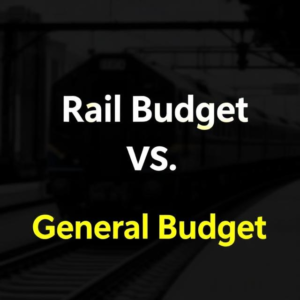What is the Annual Budget for Indian Railways?
The Annual Budget for Indian Railways is like a financial plan for the year. It details how much money Indian Railways expects to earn and how much it plans to spend. This budget helps Indian Railways to:
- Plan its operations,
- Upgrade services,
- Maintain existing infrastructure, and
- Invest in new projects.
The budget is usually presented by the Railway Minister and outlines the financial goals and priorities for the coming year.

Why is the Budget Important?
The budget is important because it sets the direction for Indian Railways for the upcoming year. It helps the government and Railway authorities make decisions on:
- How much money to invest in upgrading stations, tracks, and trains.
- How much to spend on safety, maintenance, and passenger facilities.
- How to improve services like cleanliness, train punctuality, and new routes.
Key Elements of the Railway Annual Budget
Let’s look at the main parts of the Railway Budget:
1. Revenue Projections
- Revenue is the money Indian Railways earns from selling tickets, freight charges, and other services.
- In the budget, the Railways will forecast how much money it expects to earn in the upcoming year.
- They may expect higher revenues if there are more passengers or freight, or lower revenues if there’s a dip in travel or business.
Example:
If Indian Railways expects more people to travel because of a special event or new routes, it will predict higher earnings.
2. Expenditure Projections
- This part of the budget shows how much money Indian Railways plans to spend. This includes costs for train operations, maintenance, upgrading stations, salaries of employees, and more.
- It’s essential to keep the network running smoothly, improve services, and maintain safety.
Example:
Indian Railways might spend money on upgrading tracks, buying new trains, or installing safety features like CCTV.
3. Capital Expenditure
- This is the money that Indian Railways plans to invest in long-term projects. These are bigger, one-time costs that help improve infrastructure, like building new stations, laying new tracks, or buying new trains.
- Capital expenditure helps to expand the railway network and make it more modern.
Example:
If Indian Railways decides to build a new high-speed rail corridor, it will allocate money in this section of the budget.
4. Operational Expenditure
- Operational expenditure refers to the everyday costs involved in running the trains and stations. This includes things like fuel for trains, electricity, maintenance, and salaries of workers.
- These are the costs that occur regularly to keep the trains running smoothly.
Example:
Paying for electricity used by trains and stations, and the maintenance of tracks and stations.
5. Funding Sources
- The budget also looks at where the money will come from. This could include:
- Government grants (money from the government).
- Borrowing (loans from banks or other sources).
- Earnings from freight and passenger services.
Forecasting in the Railway Budget
In addition to the actual budget, Indian Railways also makes forecasts for the future. These are predictions about how the railways will perform in the coming years.
Forecasting helps Railway authorities understand:
- How the railway system will grow.
- What challenges it might face.
- What investments are needed to meet future needs.
Types of Forecasting:
- Passenger Traffic Forecasting: Predicting how many people will travel by train and how much money will be earned from ticket sales.Example:
If Indian Railways expects more people to travel during a certain festival or event, it will forecast higher passenger traffic and revenue. - Freight Traffic Forecasting: Predicting how much goods (like coal, food, or industrial products) will be transported by rail.Example:
If there’s a rise in demand for goods like coal or steel, freight traffic will be forecasted to increase, bringing in more revenue. - Infrastructure Needs Forecasting: Estimating how much money will be required to maintain or expand the railway infrastructure, like stations, tracks, and train depots.Example:
If there is a rise in passenger traffic or freight transportation, new stations or upgraded tracks might be required to handle the extra volume. - Safety Forecasting: Predicting costs and investments needed to enhance safety features on the trains, stations, and tracks.Example:
Indian Railways may forecast the need for more safety equipment or surveillance cameras to improve passenger security.
How is the Budget Created?
- Data Collection: Indian Railways gathers data from various regions, stations, and departments about how much money it has earned, what its expenses have been, and what future needs are.
- Analysis: Experts analyze the data to predict future trends, such as how many passengers will travel, how much goods will be moved by freight, and what improvements are needed in infrastructure.
- Planning: The Railway Ministry, along with the government, decides on how to allocate funds to different projects. This involves balancing the needs for maintenance, modernization, new services, and safety improvements.
- Approval: Once the budget is finalized, it is approved by the government. The Railway Minister then presents the budget to the public, usually through the Union Budget speech.
In Summary:
The Indian Railways Annual Budget is a financial plan that sets out:
- How much money Indian Railways expects to earn and spend in a year.
- What projects and improvements it plans to focus on, like new trains, upgraded stations, or better safety.
- It is forecasted based on predictions about future passenger traffic, freight movement, and infrastructure needs.
The budget helps Indian Railways plan and prioritize its activities, ensuring it can continue to provide efficient, safe, and reliable services for passengers and freight while investing in long-term growth.
Keywords: Indian Railway, Railway











